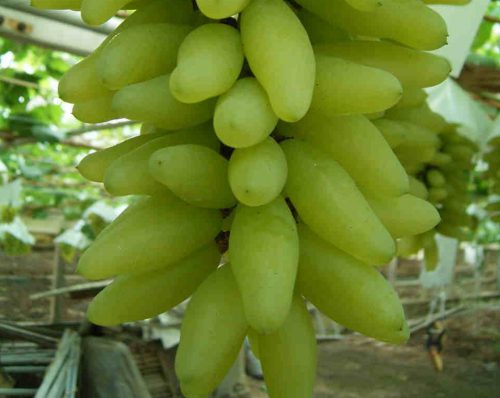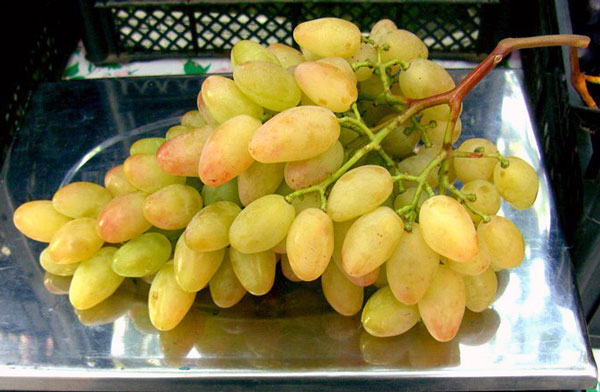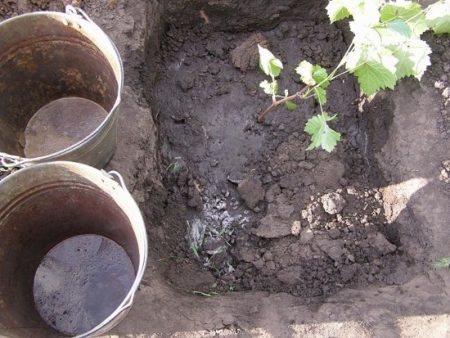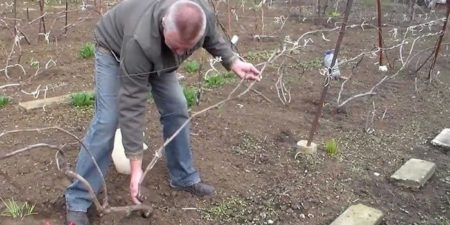For those who want to grow large grapes, the Gold Finger variety is ideal. Bred by Japanese scientists relatively recently. Beautiful large grapes gather in powerful clusters, they hang for a long time and do not crumble. Gold Finger has a rich sweet taste that everyone will like. About the characteristics and characteristics of the cultivation of the variety is presented in the description of the variety with photos and reviews.
Grade description
 Gold Finger is considered an early variety, since it takes no more than 120 days to fully mature. Ripening usually occurs in late August or early autumn. By this time, large berries appear on the vine weighing 6-9 g of yellow-green color. The berries are slightly elongated in shape, there are a couple of seeds in the pulp. The skin is durable, reliably protects the fruit from cracking. The taste is slightly felt astringency and fruity aroma, reminiscent of labruscu. The sugar content in the grape is 20-22 g, the acidity is low.
Gold Finger is considered an early variety, since it takes no more than 120 days to fully mature. Ripening usually occurs in late August or early autumn. By this time, large berries appear on the vine weighing 6-9 g of yellow-green color. The berries are slightly elongated in shape, there are a couple of seeds in the pulp. The skin is durable, reliably protects the fruit from cracking. The taste is slightly felt astringency and fruity aroma, reminiscent of labruscu. The sugar content in the grape is 20-22 g, the acidity is low.
Gold Finger is bred for fresh consumption. In their homeland in Japan, grapes are grown using special growth regulators. Berries become more elongated, and their tip is pointed. The fruit resembles a finger in shape, which explains the name of the variety. Gold Finger is suitable for making light and strong wines, compotes, jams.
Strongly bush (height 6 m), requires annual formation. At the beginning of cultivation, all the shoots are separated and n allow them to intertwine. Initially, the twisted vine cannot be unraveled. The variety is recognized as medium-yielding. The indicator averages 100 centners per year. In the first years after planting, the indicator may be lower, but when the plant reaches the age of seven, the grape bears fruit in full power. The ripening of berries is almost one hundred percent.

The variety is recommended for planting in regions with a warm and temperate climate. Grapes love the sun, to obtain sweet berries and maximum yield, the length of daylight should be at least 10 hours. In regions with a harsh climate, where winter begins early and the temperature drops below -25 degrees, Gold Finger is not grown. Shoots have a maximum frost resistance of up to - 20 degrees. Shelter is required.
In terms of immune capabilities, the variety is not inferior to modern competitors. Grapes are rarely infected and more viruses and fungi. In order to maintain high-level immune properties, fungicidal drugs are prevented every year.
The advantages of Gold Finger include:
- beautiful appearance of berries and sweet taste;
- high and stable yield;
- early ripening;
- universal application;
- disease resistance.
Gold Finger has flaws. In rainy summers, berries are prone to cracking. The skin does not stand up and bursts with time, and the allocated sweet juice attracts the attention of wasps.
Landing
 Gold Finger is planted 2 times a year: in autumn and spring. Autumn planting is preferable for the southern regions, in the central part it is customary to plant a crop in the spring, in April.
Gold Finger is planted 2 times a year: in autumn and spring. Autumn planting is preferable for the southern regions, in the central part it is customary to plant a crop in the spring, in April.
A grape pit is prepared in 2 weeks and filled with it:
- drainage (bucket);
- manure (3-4 kg);
- mineral fertilizers (superphosphate, potassium sulfate in an amount of 100 g);
- ash (glass per 1 sq.m.).
When digging a hole, it is divided into 2 layers: lower and upper. When the seedling is instilled, at the beginning the roots are covered with a layer that was on top, and then the remaining soil is added. At the end of planting, water the plant with water and mulch the soil.
Care
Care for grapes is minimal, does not require much time. However, they can not be neglected, otherwise fruiting will be sluggish. To Gold Finger pleased with the harvest in the near future, you need:
- periodically unload the bush. Young cuttings that do not yet bear fruit are separated from the main stem and rooted in the ground or in the water. They can be used for planting;
- break off old shoots. In the springtime, before the buds open, all dry and diseased shoots break off with their hands or cut off with secateurs. If the branch is weak, noticeably lags behind others in growth, it is also removed;
- tie the vine; The shoots are always asked the right direction, otherwise they will be intertwined;
- infrequently watered. For a year, grapes are watered only 4 times, not more often: after winter, before flowering, before fruiting, before shelter for the winter.
Simple rules will help to grow a healthy crop, and the grapes themselves will live long.
Winter preparations
 After fruiting, the vine is allowed to mature. If the shoots become dry, and the trunk itself is straw-colored, then the grapes can be harvested for the winter. Cut the vine at an angle of 3-4 cm above the upper ocellus. When removing one-year dry shoots, hemp is not left: pruning is performed at the very root. The vine cut from branches and leaves is removed and bundled. On the ground they put mulch, spruce branches. The bundles are bent to the ground and fixed in this position. Spanbond or agrofibre is placed in the upper layer; a film is used to protect materials from moisture.
After fruiting, the vine is allowed to mature. If the shoots become dry, and the trunk itself is straw-colored, then the grapes can be harvested for the winter. Cut the vine at an angle of 3-4 cm above the upper ocellus. When removing one-year dry shoots, hemp is not left: pruning is performed at the very root. The vine cut from branches and leaves is removed and bundled. On the ground they put mulch, spruce branches. The bundles are bent to the ground and fixed in this position. Spanbond or agrofibre is placed in the upper layer; a film is used to protect materials from moisture.
Reviews
Lyudmila from the Krasnodar Territory wrote:
“This year, the berry is slightly overripe, it tasted too sweet. Summer turned out to be hot, so Gold Finger began to keep up with ripening in mid-August. When biting, the berries crunch a little. The variety does not get sick; shoots develop quickly. The grapes propagate well by cuttings, and the number of plantings has already increased by 2 times. ”
Konstantin from Kaliningrad writes:
“For our region, the Gold Finger variety came up. For the winter I only dig a vine into the ground, I did not cover it with a film. Even if several shoots are frozen, they quickly recover and grow further. The shape of the berries is ordinary, but the taste is sweet, sourness is not felt. "




 Non-covering winter-hardy grape varieties for Moscow region
Non-covering winter-hardy grape varieties for Moscow region How to keep the vine in winter
How to keep the vine in winter When can I transfer grapes to another place in the fall
When can I transfer grapes to another place in the fall How to cover and prepare grapes for the winter in the suburbs
How to cover and prepare grapes for the winter in the suburbs